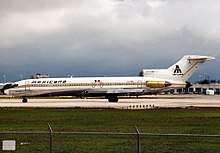Mexicana Flight 940
 A Mexicana Boeing 727, similar to the one involved | |
| Accident | |
|---|---|
| Date | March 31, 1986 |
| Summary | In-flight fire due to maintenance error, leading to loss of hydraulic and electrical systems. |
| Site |
Michoacán, Mexico 19°50′05.2″N 100°18′27.3″W / 19.834778°N 100.307583°WCoordinates: 19°50′05.2″N 100°18′27.3″W / 19.834778°N 100.307583°W |
| Aircraft | |
| Aircraft type | Boeing 727–264 |
| Aircraft name | Veracruz |
| Operator | Mexicana de Aviacion |
| Registration | XA-MEM |
| Flight origin | Benito Juárez International Airport |
| 1st stopover | Lic. Gustavo Díaz Ordaz International Airport |
| Last stopover | General Rafael Buelna International Airport |
| Destination | Los Angeles International Airport |
| Passengers | 159 |
| Crew | 8 |
| Fatalities | 167 |
| Survivors | 0 |
Mexicana Flight 940, operated by Mexicana Airlines (Compañia Mexicana de Aviación), was a scheduled international flight from Mexico City–Puerto Vallarta–Mazatlán–Los Angeles on March 31, 1986, utilizing a Boeing 727-200 registered as XA-MEM,[1] when the plane crashed into El Carbón, a mountain in the rugged Sierra Madre Occidental mountain range northwest of Mexico City, killing everyone on board.[2]
History
The plane, nicknamed "Veracruz" was delivered to Mexicana in 1981[3] and was piloted by Captain Carlos Guadarrama Sistos, an experienced Mexican captain with over 15,000 hours of flying experience, first officer Pillip L. Piaget Rohrer, and flight engineer Ángel Carlos Peñasco Espinoza. The crew of eight included five flight attendants; the wife of the captain, who was a retired flight attendant, and the captain's son and daughter were also among the 159 passengers on board.[4] At 08:50 local time, the plane took off from Benito Juárez International Airport en route to Los Angeles International Airport with scheduled stopovers in Puerto Vallarta and Mazatlán.[5] The plane carried 147 passengers (139 passengers and 8 crew members) from Mexico, 8 from France, 6 from the United States, 4 from Sweden, and 2 from Canada.[6]
Crash
At 09:05, fifteen minutes after takeoff, an explosion rocked the fuselage. Captain Guadarrama and the crew in the cockpit, realizing that the plane was shaking too much, declared an emergency and asked to return to Benito Juárez International Airport for an emergency landing.[7] The airport was prepared for the landing. However, the aircraft crashed into El Carbón mountain near the town of Maravatío, Michoacán, broke in two and burst into flames.[7] All 167 passengers and crew were killed upon impact.[8] Eyewitnesses reported details of the crash to authorities. The local police and the Mexican army were dispatched to the crash site.[9]
Investigation

Initially, two Middle Eastern terrorist groups claimed responsibility for this crash, along with the bombing of TWA Flight 840, which occurred just two days later. An anonymous letter signed by those groups claimed that a suicide mission had sabotaged the plane in retaliation against the United States.[10][11] However, sabotage was later dismissed as a cause of the crash. The investigations were carried out by the U.S. National Transportation Safety Board and Mexican aeronautical authorities, who found that the cause of the accident was that the center landing gear tire was filled with compressed air, instead of nitrogen.[7] In addition, the tire had some marks of overheating. The investigators later found that the overheating was caused by a malfunctioning brake on the landing gear.[12]
Aftermath
Mexicana maintenance personnel were blamed for negligence in maintaining the 727 and for filling the tire with compressed air, instead of nitrogen. The crash remains the deadliest airline disaster in Mexican history[13] and is the world's deadliest air disaster involving the Boeing 727. The cause of the in-flight fire is believed to be the rupture of fuel lines by the exploding tire.[14]
See also
- Nigeria Airways Flight 2120 - A similar crash where under-inflated tyres overheated and started a fire onboard which destroyed vital hydraulic and control cables leading to a loss of control
- Air France Flight 4590 - A 2000 Concorde crash caused by an inflight fire triggered by tire burst on takeoff
- Swissair Flight 306 - A 1963 crash caused by an inflight fire triggered by a landing gear failure on takeoff
- ValuJet Flight 592 - A 1996 crash caused by an inflight fire in the cargo hold
References
- ↑ "ASN Aircraft accident Boeing 727-264 XA-MEM Las Mesas", AviationSafety.net.
- ↑ Seiler, Michael (April 1, 1986). All 166 on Jet Die in Mexican Crash. Los Angeles Times
- ↑ "XA-MEM - Boeing 727-264(Adv) - 22414 - JetPhotos". JetPhotos. Retrieved 8 January 2018.
- ↑ "Pilot's Family Killed, Wife Had Survived Earlier Crash With Mexico-Plane". www.apnewsarchive.com. Retrieved 8 January 2018.
- ↑ "La mayor tragedia aérea en el país; 166 personas murieron hace 30 años". 31 March 2016. Retrieved 8 January 2018.
- ↑ "Un Boeing 727 se estrella en México con 166 personas a bordo" [A Boeing 727 crashes in Mexico with 166 people on board] (in Spanish). Hemeroteca El País - Espanha. 1 April 1986. Retrieved 28 October 2013.
- 1 2 3 "The Crash of Mexicana de Aviacion Flight 940". ecperez.blogspot.co.nz. Retrieved 8 January 2018.
- ↑ SEILER, MICHAEL (1 April 1986). "All 166 on Jet Die in Mexican Crash : Mexicana 727, En Route to L.A., Hits Mountain West of Capital and Burns". Retrieved 8 January 2018 – via LA Times.
- ↑ "Bodies recovered from mountain crash site". Retrieved 8 January 2018.
- ↑ Levi, Isaac A. (April 4, 1986). Mexican jet pilots claim plane crash caused by explosion. Kentucky New Era (AP).
- ↑ "The Montreal Gazette - Google News Archive Search". news.google.com. Retrieved 8 January 2018.
- ↑ The Montreal Gazette (AP), April 5, 1986.
- ↑ Fields, Dana (May 23, 1986). Explosion, fire preceded plane crash that killed 167. Nashua Telegraph (AP).
- ↑ Ranter, Harro. "ASN Aircraft accident Boeing 727-264 XA-MEM Las Mesas". aviation-safety.net. Retrieved 8 January 2018.